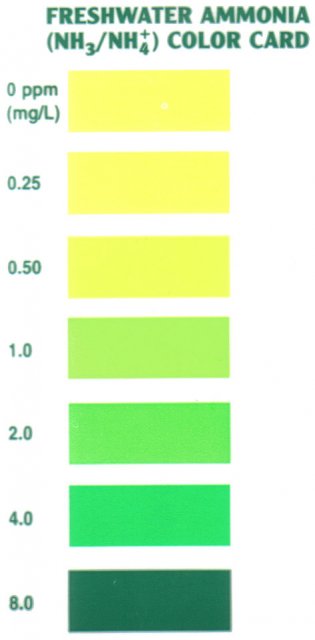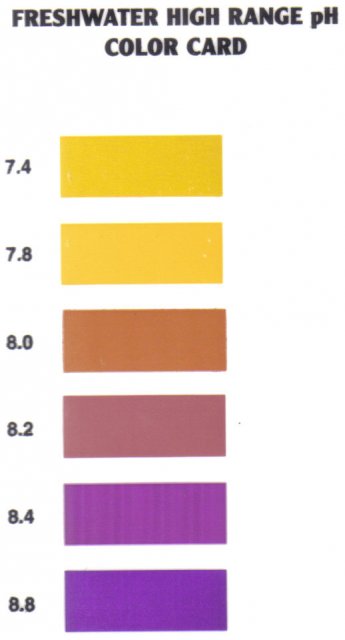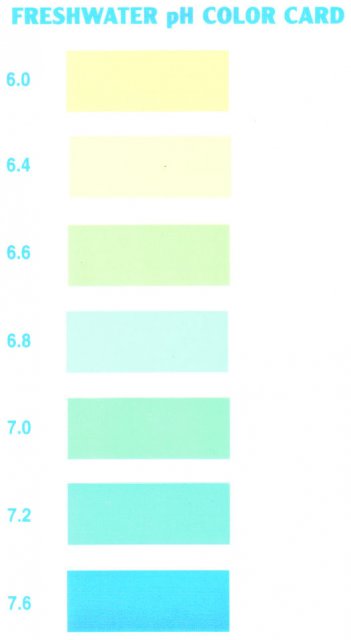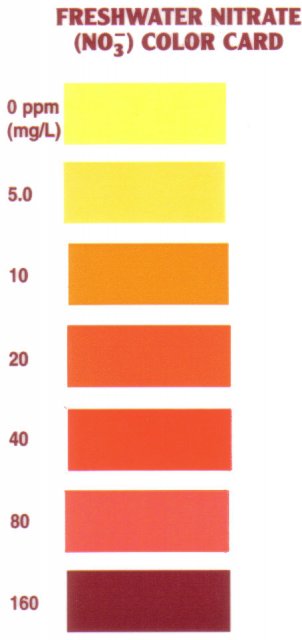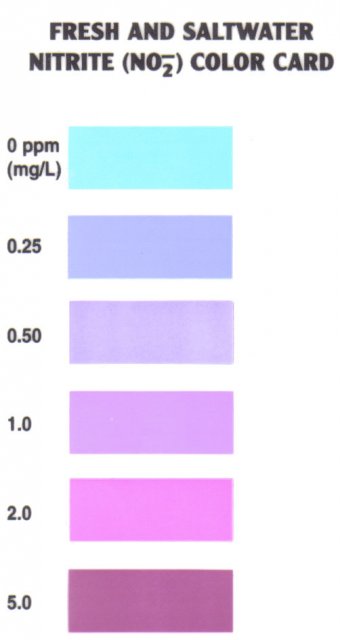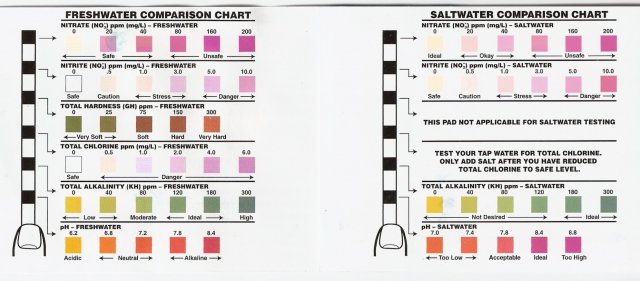test kit database, FAQ
- Thread starter orthikon
- Start date
You are using an out of date browser. It may not display this or other websites correctly.
You should upgrade or use an alternative browser.
You should upgrade or use an alternative browser.
others i dont know but i do know about the api kits.
In response to your question, each reagent bottle has a Lot # printed on
the bottle. The last four digits are the month and year of manufacture.
Example: Lot # 28A0102. This is a pH reagent manufactured in January of
2002. Pond Care Wide Range pH, Ammonia, High Range pH, Nitrate,
Phosphate, Copper, Calcium and GH all last for three years. Nitrite and
KH will last for four years. Freshwater pH(low range) and Pond Care Salt
Level will last for five years. I would not trust these kits after they
have expired.
In response to your question, each reagent bottle has a Lot # printed on
the bottle. The last four digits are the month and year of manufacture.
Example: Lot # 28A0102. This is a pH reagent manufactured in January of
2002. Pond Care Wide Range pH, Ammonia, High Range pH, Nitrate,
Phosphate, Copper, Calcium and GH all last for three years. Nitrite and
KH will last for four years. Freshwater pH(low range) and Pond Care Salt
Level will last for five years. I would not trust these kits after they
have expired.
Lupin
Registered Member
- Sep 21, 2006
- 21,430
- 13
- 0
- Real Name
- Paul
Lupin
Registered Member
- Sep 21, 2006
- 21,430
- 13
- 0
- Real Name
- Paul
Update:
Pics posted by Kveeti have been fixed as they were broken. This time, I attached them to AC's uploading system so the pics won't be lost over time.
Thanks again for the pics, Kveeti.
Pics posted by Kveeti have been fixed as they were broken. This time, I attached them to AC's uploading system so the pics won't be lost over time.
Thanks again for the pics, Kveeti.
Does anyone have a picture of the freshwater comparison chart of the jungle labs 5 in 1 quick dip test strips? Ours got wet and stuck to the bottle so when we went to pull it open it tore.
Will this do?Does anyone have a picture of the freshwater comparison chart of the jungle labs 5 in 1 quick dip test strips? Ours got wet and stuck to the bottle so when we went to pull it open it tore.

1oooop
int x; if {x>1} {std::cout
Does anyone have the API GH/KH Chart available? Knowing me, I'm gonna lose that slip of paper sooner or later. Or even better, a chart with more specific values instead of a range?
A few ideas for better / easier testing
I've noticed that more than a few ancients like myself have a difficult time matching test sample to color card. The issue of lighting brought to mind graphics work that we used to do in the exhibit world, where clients were constantly fretting over color matches. The problem is that because of the way we see color, we are dependent on light levels and the colors surrounding what we are looking at. (Wiki rods and cones for a better explanation)
Where water testing is concerned I would suggest that consistency is paramount, we can deal with accuracy separately. Observing colors under the same conditions will go a long way toward establishing that, and helping us old folks so we don't stumble all over the house and yard looking for just that right light to unveil what we seek.
Build a small light box, open in the front and across the top (1/2" plywood glued and pinned should be more than adequate). The size need only accommodate the color card and your hand holding the test vial...say 12" wide if you want to stick both hands in at once. For simplicity's sake let's just make the whole box a foot square with no front and no top.
Paint the interior of the box flat pure white and attach a compact fluorescent fixture across the top. Finish by adding strips along side the fixture to close off the rest of the box top and screw it to the wall or your significant others favorite piece of furniture, er ...disregard that last bit.
I haven't researched it as yet but I'm sure a true color spectrum bulb is available. This is kind of tricky too however because they all tend to favor either the blue or red spectrum one way or the other...but again what we seek here is consistency...and a bright enough light that we can test anytime.
It is actually a fact that the over 40-50 crowd needs something like twice the light intensity that youngsters need to be able to work safely so it just goes to figure that having a good viewing area handy will make the whole process easier for me and my AARP peers.
Regarding accuracy, the previous points about anything above zero being the important indicator, I couldn't agree more, but for the OCD among us who need to know just how bad it is, or reassurance that it's not, here are a few ideas.
Use an eye dropper, baster or syringe to inject your water sample into the test vial. I have a lot of tanks to test so I purchased extra vials and burned some holes in a plastic foam base to hold them. Each tank gets its own set of vials and its own syringe. This is just so I don't cross contaminate tanks and so I'm not contaminating my samples with rinse water between tests. Also a lot less walking back and forth.
I take a small 1/2 cup sized sample from each tank and line them up with the vial stand before I start filling vials from the cups. The surface tension of the water on the inside of the vial causes the center of your reading to appear lower than where it contacts the glass. Again, just be consistent. Use the lowest part of your sample to register against the mark on the vial if you wish but just make sure that you always use that same criteria.
Agitate your samples the same each time and check the time that you let them stand. Some test results are fairly immediate but others, like nitrates, tend to take a little longer to develop their final test color.
When finished rinse everything out real well and store open end up so that they air dry completely before your next test. I'm not sure that the juice is worth the squeeze, but there may be some impact provided by your rinse water and any residue that it may impart, depending on the water quality of your supply.
I'm on the Baltimore Metro system and we have very soft and generally very high quality water to begin with (albeit with varying levels of chlorinates depending on the time of year). I grew up in Pittsburgh, where the public water supply had a distinct texture and turbid opacity that warned you not to drink it.
Real time indicators and digital testers aside a previous poster's reference to LaMotte was also a good way to go, if ya can spare the coin. I've used the LaMotte kits in pond and pool construction as well as with Trout Unlimited and SOS (Save Our Streams) and they are really top notch, but you still need to be able to see he test results.
Not an expert by any means, but you may find this useful. I haven't built one yet myself, but it's on the list.
I've noticed that more than a few ancients like myself have a difficult time matching test sample to color card. The issue of lighting brought to mind graphics work that we used to do in the exhibit world, where clients were constantly fretting over color matches. The problem is that because of the way we see color, we are dependent on light levels and the colors surrounding what we are looking at. (Wiki rods and cones for a better explanation)
Where water testing is concerned I would suggest that consistency is paramount, we can deal with accuracy separately. Observing colors under the same conditions will go a long way toward establishing that, and helping us old folks so we don't stumble all over the house and yard looking for just that right light to unveil what we seek.
Build a small light box, open in the front and across the top (1/2" plywood glued and pinned should be more than adequate). The size need only accommodate the color card and your hand holding the test vial...say 12" wide if you want to stick both hands in at once. For simplicity's sake let's just make the whole box a foot square with no front and no top.
Paint the interior of the box flat pure white and attach a compact fluorescent fixture across the top. Finish by adding strips along side the fixture to close off the rest of the box top and screw it to the wall or your significant others favorite piece of furniture, er ...disregard that last bit.
I haven't researched it as yet but I'm sure a true color spectrum bulb is available. This is kind of tricky too however because they all tend to favor either the blue or red spectrum one way or the other...but again what we seek here is consistency...and a bright enough light that we can test anytime.
It is actually a fact that the over 40-50 crowd needs something like twice the light intensity that youngsters need to be able to work safely so it just goes to figure that having a good viewing area handy will make the whole process easier for me and my AARP peers.
Regarding accuracy, the previous points about anything above zero being the important indicator, I couldn't agree more, but for the OCD among us who need to know just how bad it is, or reassurance that it's not, here are a few ideas.
Use an eye dropper, baster or syringe to inject your water sample into the test vial. I have a lot of tanks to test so I purchased extra vials and burned some holes in a plastic foam base to hold them. Each tank gets its own set of vials and its own syringe. This is just so I don't cross contaminate tanks and so I'm not contaminating my samples with rinse water between tests. Also a lot less walking back and forth.
I take a small 1/2 cup sized sample from each tank and line them up with the vial stand before I start filling vials from the cups. The surface tension of the water on the inside of the vial causes the center of your reading to appear lower than where it contacts the glass. Again, just be consistent. Use the lowest part of your sample to register against the mark on the vial if you wish but just make sure that you always use that same criteria.
Agitate your samples the same each time and check the time that you let them stand. Some test results are fairly immediate but others, like nitrates, tend to take a little longer to develop their final test color.
When finished rinse everything out real well and store open end up so that they air dry completely before your next test. I'm not sure that the juice is worth the squeeze, but there may be some impact provided by your rinse water and any residue that it may impart, depending on the water quality of your supply.
I'm on the Baltimore Metro system and we have very soft and generally very high quality water to begin with (albeit with varying levels of chlorinates depending on the time of year). I grew up in Pittsburgh, where the public water supply had a distinct texture and turbid opacity that warned you not to drink it.
Real time indicators and digital testers aside a previous poster's reference to LaMotte was also a good way to go, if ya can spare the coin. I've used the LaMotte kits in pond and pool construction as well as with Trout Unlimited and SOS (Save Our Streams) and they are really top notch, but you still need to be able to see he test results.
Not an expert by any means, but you may find this useful. I haven't built one yet myself, but it's on the list.


